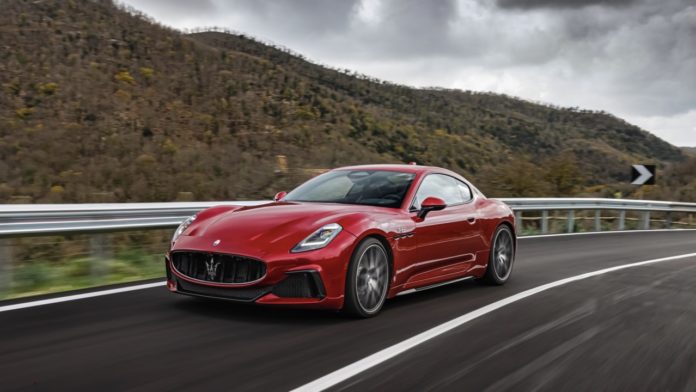I’m jetlagged, but it’s all good. I’m in the pocket of a sleek, leather-lined four-seater, flipping its shift paddles to goose its twin-turbo V-6, strafing the countryside northwest of Rome. I’m all, oh, look, there’s an olive grove and oh, look, a thousand-year-old aqueduct. Meanwhile, I’m hoovering up pavement like the Italian cream buns at the Colosseum Cafe when not being squeezed into a half-lane by wandery Iveco box trucks.
Forty-eight hours earlier, I’d been filing my taxes and scooping the litter box. Gran turismo? You bet your maritozzo it is, notwithstanding the joys of 1099-INT forms and all.
The Maserati GranTurismo has been touring in style for decades, with a lineage that traces back 75 years to the A6 1500, until now powering its gorgeous body with scintillating gas engines. Today it’s one of a dying breed: Few cars put the “grand” in touring anymore, and for every flawless descendant like the Lexus LC, there are the ones that got away, like the soon-to-be-deceased Jag F-Type.
Maserati hopes to fend off the same fate with a wrench it’s tossing in the traditional formula: a battery-powered version dubbed the Folgore, which synthesizes some of the whuffling drive-by sounds of the “Nettuno” twin-turbo V-6, while putting the gas version on the trailer with scorching EV acceleration that jams batteries in places where twisting and combusting used to take place. It’s eerily quiet; it’s relentlessly quick; it’s entirely without precedent.
The Folgore is a rather dramatic departure. Will it stick? Or will traditionalists starve it off in favor of that whuffling Nettuno V-6?
2024 Maserati GranTurismo Trofeo

2024 Maserati GranTurismo Trofeo
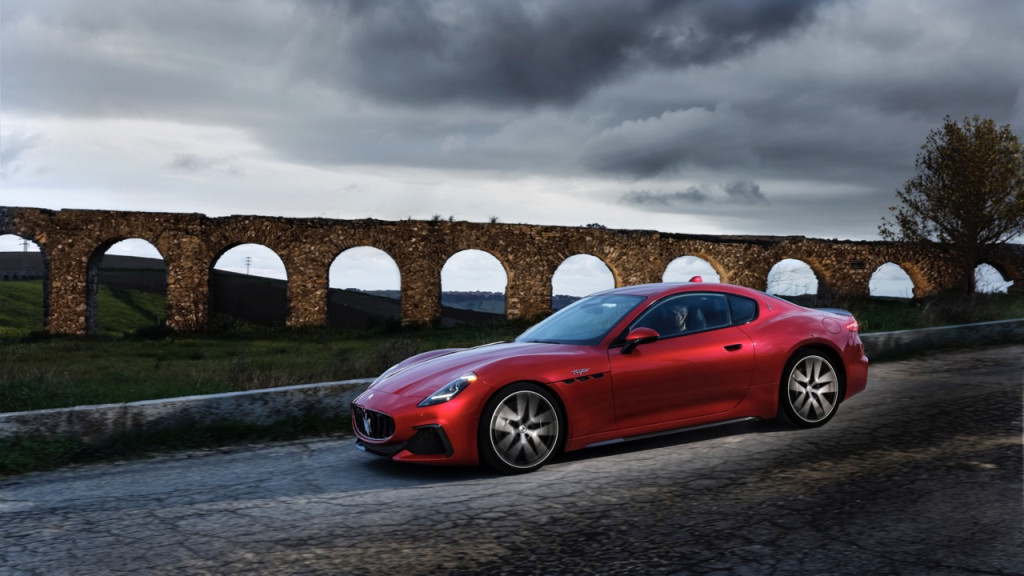
2024 Maserati GranTurismo Trofeo
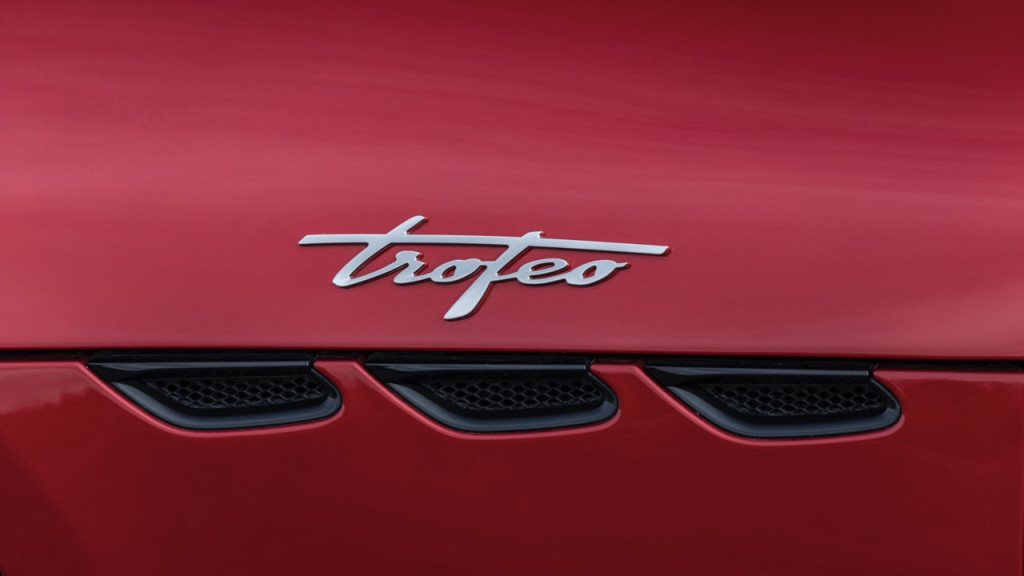
2024 Maserati GranTurismo Trofeo
2024 GranTurismo: Curves, controlled
To massage that transition, the GranTurismo’s style changes only subtly from the previous version, which last was sold in 2019. It stands in a classic touring-car contrapposto, with a long hood, a short decklid, maximally swole fenders, and ticks and stripes of metallic trim to draw attention to the most sculptural passages of its body. It sits lower than before, which translates into a lower seating position for driver and front passenger, and it’s also wider—but the classic elements fall into place with a natural grace, from the trident badge in its slim oval grille to the trim LED taillights. Forward-angled fender vents are a love-them-or-leave-them detail; we assign them a heart emoji. Trofeos wear some lily-gilding carbon-fiber trim.
The GranTurismo’s cabin empanels digital screens in its tech-forward transformation. A 12.2-inch digital gauge display pairs with a 12.3-inch infotainment touchscreen, which sits above an 8.8-inch climate-control touchscreen. It doesn’t chuck the past entirely in the bin. Glorious textures polish the cockpit to a sheen: aluminum grilles for speakers fit beautifully in an interior that even digitizes the round clock that studs the center of the dash, while the lower dash wears diamond-slitted scars that add a dash of style to some otherwise plain expanses of trim. Minus some shiny plastic steering-wheel switches, it’s an artful workplace.
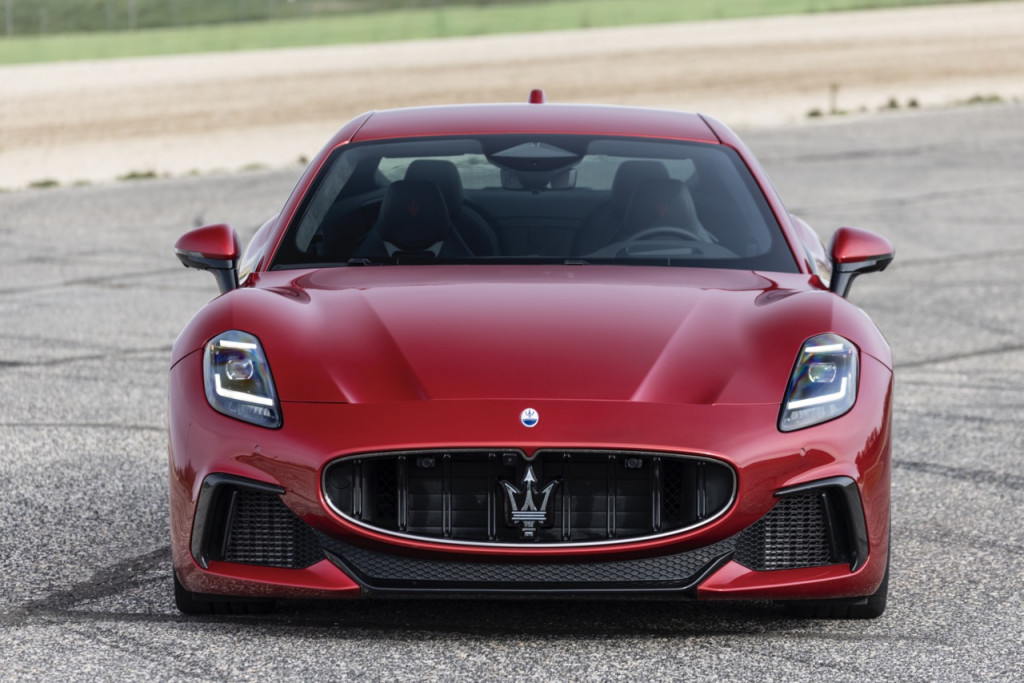
2024 Maserati GranTurismo Trofeo
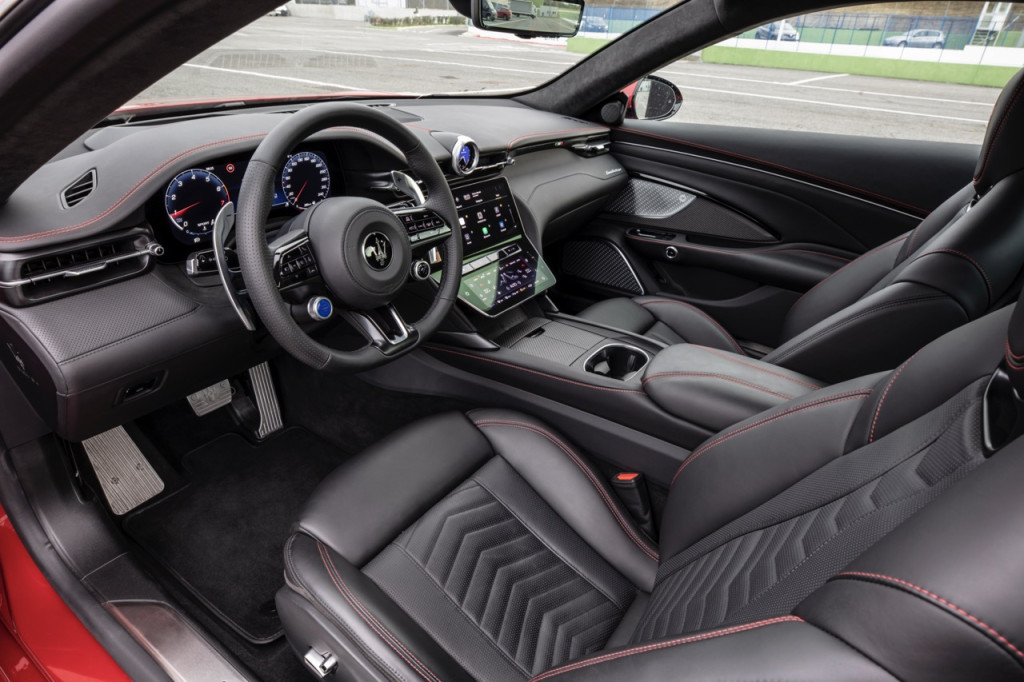
2024 Maserati GranTurismo Trofeo

2024 Maserati GranTurismo Trofeo
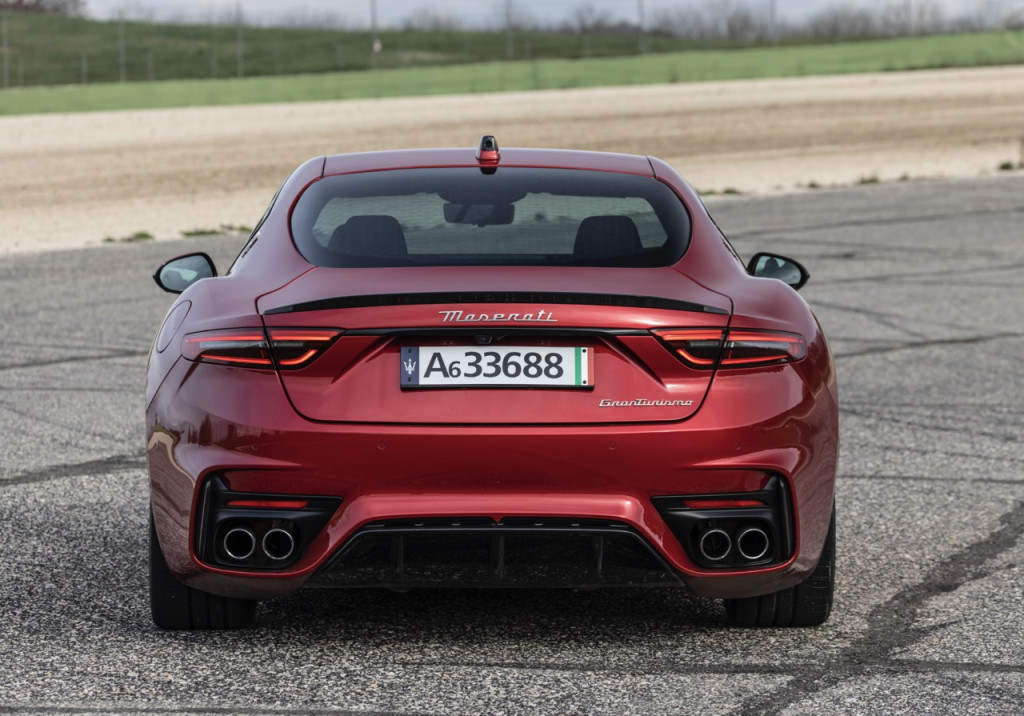
2024 Maserati GranTurismo Trofeo
2024 GranTurismo: Rip, snort, slice
With the MC20 supercar’s 3.0-liter twin-turbo V-6 nestled in its engine bay, the gas-powered GranTurismo roars forward with a hovercraft-style exhaust note that fits the end of its internal-combustion era. In the MC20 the Nettuno engine gets more power and dry-sump lubrication; in the GranTurismo Modena it spins out 490 hp and, in the Trofeo, a spec-champ 550 hp.
Paired with the standard paddle-shifted 8-speed automatic and all-wheel drive, Maserati claims a 0-60 mph time of 3.5 seconds for the hotter Trofeo—which seems out of reach when activating the GT’s beast mode through the plastic transmission buttons on the dash, or when considering its relatively light curb weight that nonetheless checks in at 3,957 pounds, but comes into Canon-quick focus once you stomp the gas and unleash its raucous, war-wagon powertrain.
Channeling the best of the free-revving V-6 to the wheels takes little work. Finding the ideal drive mode, that’s a snap too. Skip the Comfort mode unless you’re on a hundred-mile highway chase. Otherwise the GranTurismo’s default GT mode cuts down on the exhaust snarl below 5,000 rpm while it strikes the responsive midpoint in shift quality. There’s Sport for aggro exhaust sounds and rifle-quick shifts, or Corsa, where all the slack filters out of the drivetrain and the traction and stability control systems shake their heads and walk away.
I sampled Corsa briefly, spooled out kilometers of side roads in GT mode, but kept returning to Sport to settle the GranTurismo in its happiest mode. It’s less about the drivetrain and its light-touch steering than about the suspension setup. In Comfort, the stiff dampers, big staggered 20-inch front and 21-inch rear wheels (with 265/30 front and 295/35 rear tires), and a softly set air suspension jittered over small potholes and generated head toss. In Sport, with its air springs suitably firm, the GranTurismo resolved almost every pavement quibble neatly, getting into a groove at moderate to high speeds, smoothing it out and giving it even-keeled grip.
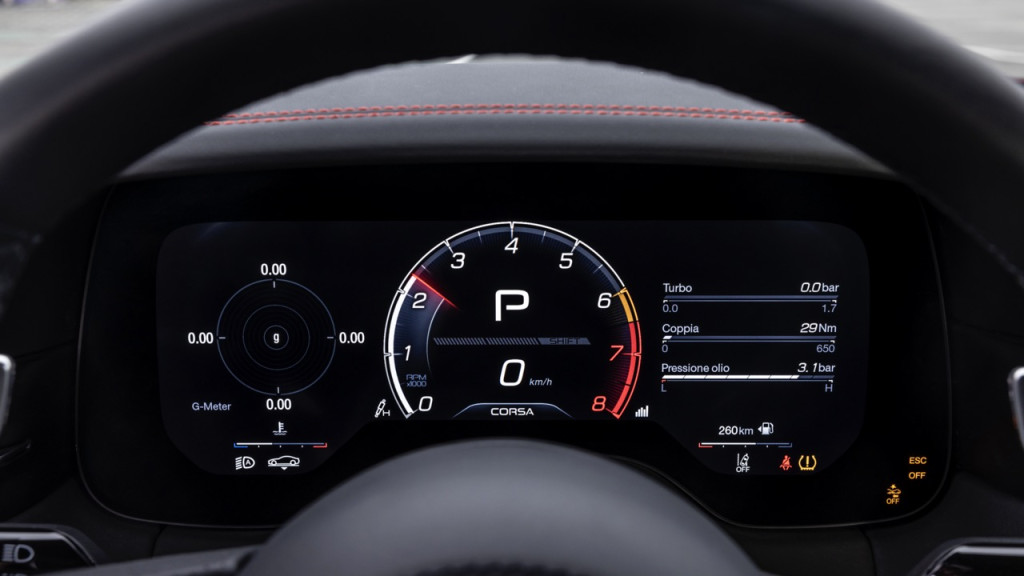
2024 Maserati GranTurismo Trofeo
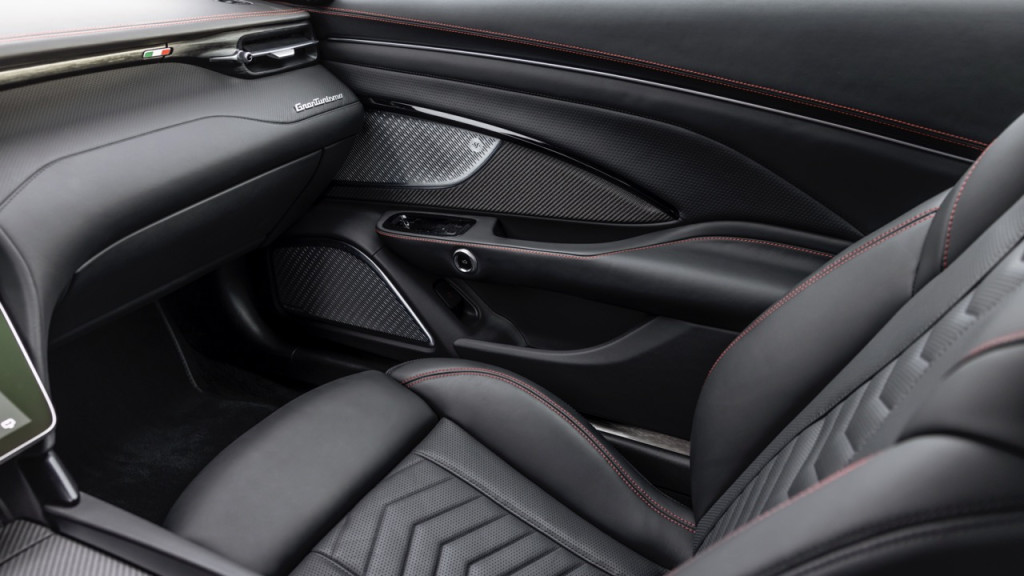
2024 Maserati GranTurismo Trofeo
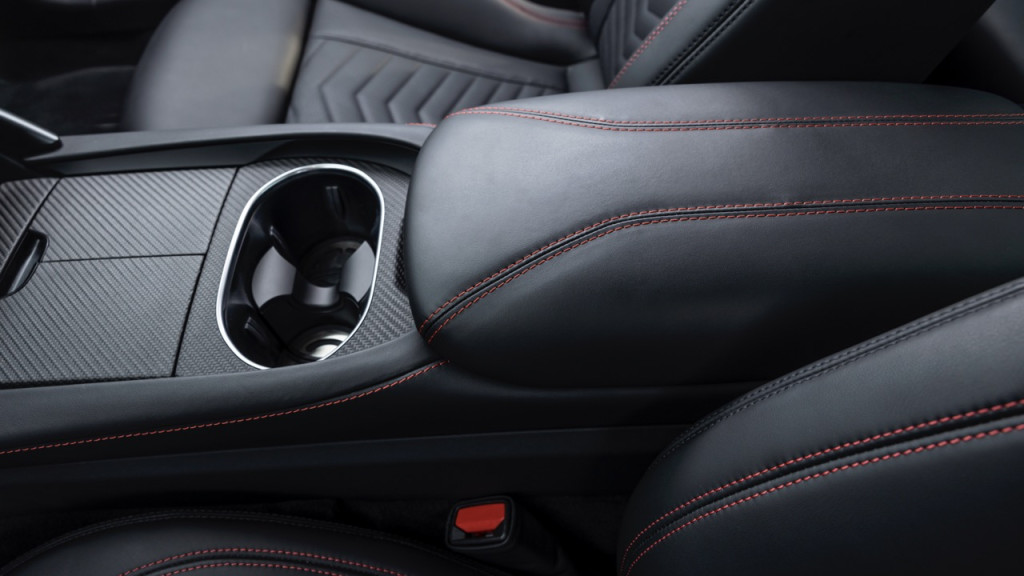
2024 Maserati GranTurismo Trofeo

2024 Maserati GranTurismo Trofeo
Grand-touring cuffing season
The GranTurismo is a big boy, at about 195.5 inches long—about the size of a Lucid Air—with a 115.3-inch wheelbase. Maserati promises four large adults can fit inside, and a quick test of the backseat proved that true, with 6-footer in front of 6-footer. Who’d want to ride in back is anyone’s guess, given the sensory pleasures of everything experienced in row one.
The front seats take some finagling to find their sweet spot, and the seats have very firm cushions, but they adjust in all the right ways, with lumbar boosting and waist-cinching controls available at a tap on the lower console screen. Maserati dresses the cabin in nutella-brown ash trim, with perforated black leather ribbed in yellow or red or gray—or in red or white leather if you’re daring. The real packaging surprise? A truly useful trunk, with enough room for at least three wheeled bags.
As either a Modena or a Trofeo, the GranTurismo has wireless Apple CarPlay and Android Auto. A sybaritic 14-speaker Sonus Faber sound system comes standard, with a 19-speaker setup on the options list, along with a head-up display and a rear camera mirror. All cars come with automatic emergency braking, a surround-view camera system, and active lane control.
Yet to come are the GranTurismo convertible, called GranCabrio in some markets—and the Folgore, the battery-electric GranTurismo that will give Maserati a unique way to core-sample its owners’ preferences.
Folgore EV: a test of the true believers
Maserati will use Folgore on all of its EVs, including upcoming electric versions of the Grecale crossover and MC20 supercar. The GranTurismo is the name’s and idea’s maiden voyage, and it comes wrapped in even more fetching finishes—among them, coppery paint on the body and brake calipers, wheels that look like wound motors, and a denim-and-ivory interior two steps beyond fabulous.
What’s missing is the Nettuno’s chatty exhaust. In its place, Maserati subs in a synthesized soundtrack culled from inverter and electric-motor noises, and amplified subtly inside the cabin. It’s an EV, and noises aside, it’s otherwise nearly impossible to tell it apart from the gas-powered car. That’s intentional, Maserati engineers say, because the transition to electric propulsion will be a complicated topic for a brand with heritage so steeped in motorsports.
Press the start button and the GranTurismo Folgore does a digital wink to acknowledge you as the driver; then, silence. Nothing seems different in the cockpit, because its 92.5-kwh battery pack takes the place of gas-propulsion bits, from the engine to the differentials. Polish-sourced LG Chem batteries form a T-bone tucked into the driveline tunnel and stacked up behind the rear seats, adding at least 1,300 pounds to the body (for a total of about 4,850 pounds) while improving weight distribution to 50:50, versus the gas car’s 53:47 split.
Three motors—one in front, two in the back—team with the batteries and an 800-volt architecture to generate 760 hp and, maybe most importantly, a 0-60 mph time of 2.7 seconds and a top speed of 199 mph. That’s with more left in the system: Engineers say the motors in the car are inverter-limited, and can spin out up to 300 kw (402 hp) each.
Still, EV cutting-edgers will murmur at some specs with eyes cast to the side. EPA-rated range will check in at a respectable 250 miles; the brand’s banking on regular battery and inverter improvements to boost performance from straight-line stellar to stratospheric.
Folgore EV: No single-pedal mode
The GranTurismo’s regenerative braking setup doesn’t have a single-pedal drive mode, either. Like a Benz EQB, it has four levels of regen that can slow the car at a force of up to 0.65 g, but it relies on friction brakes to finish the job. The modulation between the systems isn’t particularly smooth—a one-pedal setup would be the way to go here, ideally suited to the GranTurismo’s smooth-moves mission.
But the battery-powered GT accelerates more quickly and can be tailored to the driver better than the gas car. There’s a max-range drive mode in addition to the GT, Sport, and Corsa programs. In Corsa, drivers can set the torque-vectoring across the rear end separately from the traction-control levels. (There’s no mechanical connection between the rear motors, though.)
What’s even more notable about the Folgore’s performance comes from the battery layout: by wedging cells down its spine, the GranTurismo keeps a more traditional roll moment, and the ride height isn’t much different from that of the gas model. Like the Trofeo and Modena, the Folgore’s a widebody all the time, even on narrow streets than you want when a bus is taking its usual lane and a half. Its air springs and adjustable dampers flatten and hone the road better than the gas car; it’s likely less busy over roughly paved routes because of all that extra weight. The steering doesn’t compile with needless heft, and its lightness remaps the entire impression of driving the heavier GT: it’s better because it masks its weight so well.
Further in the spec weeds, the Folgore’s 800-volt architecture means high-speed charging will be possible, but Maserati has yet to name a charging provider-partner in the U.S., though it says to expect the ability to add 100 miles in around 10 minutes using a DC fast charger. We were given no opportunity to charge or to fully discharge the Folgore.
Finally, as for that distinctive sound, it barely left a memory trail. The distinctive vocals etched into RAM for the Folgore wouldn’t rank anywhere near AMG’s initial efforts at, um, notability; Dodge’s silly Fratzonic sounds come from another, far more literal galaxy. If anything, the battery-powered GranTurismo makes the gas-powered version seem too boisterous and unrefined. It puts an entirely new and different spin on the “grand” in grand touring. Now it’s up to drivers to judge whether silence sounds as good as the GranTurismo looks—or whether it’s compulsory for exotics to shout out their branding.
GranTurismos can be configured now, but the Folgore won’t be on sale until the second half of the year. Prices for the Modena model begin at $174,000; the Trofeo’s sticker will read at least $205,000. The Folgore will cost somewhat more than the Trofeo.
Maserati provided cars, travel, and a maritozzo or two so that Motor Authority could bring you this test drive review.

